
Food Review: IDZUJU (Higashiyama District, Kyoto)
Address: Kyoto-shi Higashiyama-ku Gion-cho Kitagawa 292-1
Hours: Daily 11:30-20:00 except Wednesdays
Website/Map: From Yahoo Japan (in Japanese only)
Directions: Easy. It's across the street from the Yasaka Jinja shrine, at the northwest street corner.
This is a hundred-year-old Kyoto-style Sushi restaurant at the heart of the tourist district of Gion, and one of the most anticipated restaurant visits on our trip.
Like most Sushi lovers around the world, my concept of Sushi had been largely influenced by Edomae-zushi (Tokyo-style) -- the Nigiri-zushi with a piece of irregularly cut Neta (topping) on top of a hand-shaped ball of rice. But prior to our trip I've known that the Kansai region still serves an archaic, completely different style of Sushi, and so we made very sure to visit a traditional and reputable Kyo-zushi restaurant at Kyoto's historic Higashiyama District.
With this criteria we narrowed the list down to three choices:
1) IDZU - the grand-daddy of Kyo-zushi restaurants established in 1781. Most expensive of the three.
2) IDZUJU - the offshoot of Idzu at "only" 100-years-old, but reputes to uphold the original recipe passed down from Idzu. Naturally it's cheaper than Idzu.
3) YAGURA-ZUSHI - A 250-year-old Sushi-ya situated right beside Minamiza Theatre. Seems to be less famous than the other two, and priced about the same as Idzuju.
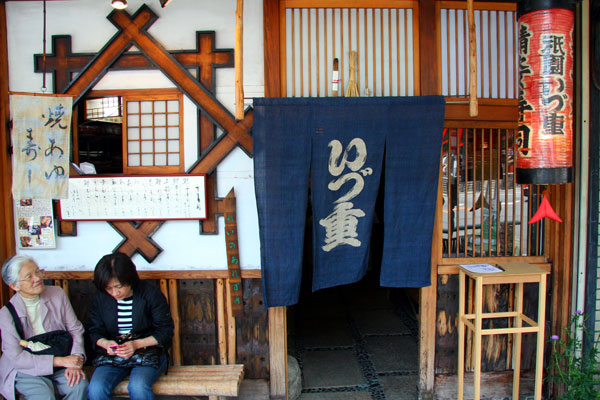
We picked Idzuju mainly because of the promise of the "original recipe" at a cheaper price, and also due to its convenient location right across from Yasaka Jinja shrine. At a glance it looked just like any neighborhood Sushi-ya, but looking closely one could see the red lantern advertising traditional "Saba Sugata-zushi", and the white cloth screen advertising the seasonal specialty of "Yaki Ayu-zushi". At this point I reasoned that if they're bold enough to advertise it outside their shop, that's what we should have.

No language barriers for 99% of tourists as far as ordering food is concerned -- the menu was written in at least four languages that I could see -- Japanese, English, French, Chinese, and occasionally even German, Spanish and Turkish! For instance Sawara was translated to "Spanish Mackerel", "Thazard Oriental", and "Carite Oriental".
As we wanted to sample the most traditional of Kyo-zuzhi, we ordered the prominently advertised Saba Sugata-zushi and Yaki Ayu-zushi, along with another Kansai specialty, the Hako-zushi (box-pressed sushi).
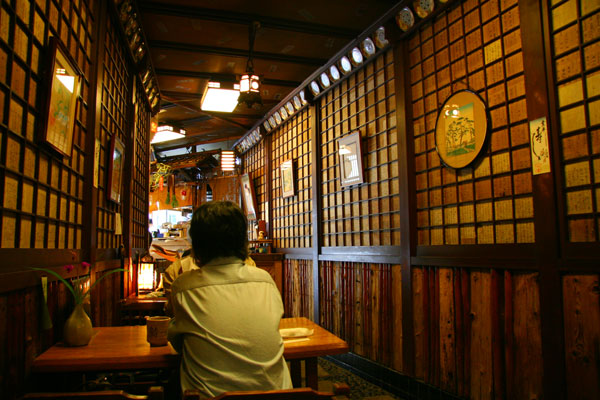
After a short 10 minutes arrived their most famous dish, the "original recipe" passed down from Idzu -- the Saba Sugata-zushi. In simple terms it was six pieces of cylindrical sushi, consisting of soft vinegared rice stuffed inside half a mackerel, then wrapped in Konbu seaweed and bamboo skin, and cured overnight.
I don't want to understate the risk I was taking -- my wife NEVER eats Saba at Sushi restaurants outside of Japan. Period. As any fan of Japanese cooking knows, Saba is an oily fish with a fairly strong taste, and goes bad very quickly -- in fact in Japan it's joked that Saba starts to go bad when it's still alive. Naturally I was worried about the effect of leaving Saba overnight for the curing, but I also reasoned that this has been one of Kyoto's famous dishes for centuries and therefore a must for a self-declared food junkie like myself. If my wife stopped after one bite, well ... I was prepared to finish the other five-and-a-half pieces.

Compared to modern Nigiri-zushi and its reliance on the freshness of ingredients, Sugata-zushi is a much older method of fish-preservation from an age without refrigeration and preservatives. The meticulous procedure requires taking a whole fish to clean, debone, and then stuff with vinegared rice, such that the original shape of the fish is presented in front the the client's eyes. This is what "Sugata" (appearance) means.
My wife took the first bite.
"Ummm you should try this it's really good!" I heard almost in disbelief, for I have never seen my wife enjoying ANY form of Saba sushi before or ever since. The fermentation process had miraculously mellowed out the strong fishy taste of the Saba, producing a mild, tender, slightly oily flesh. And the rice was no less amazing, having transformed into a buttery soft cake of semi-glutinous starch. In other words, perfection.
So there IS something special about the time-honoured recipe. According to their pamphlet they're still using "resident Saba" off the waters of Tsushima, top quality Hanabishi vinegar, and bamboo skins from Takefu -- I have no idea what these ingredients are, but it just shows the kind of committed obstinacy towards the upkeeping of traditional excellence.

After that it was time to move onto another classic Kansai specialty -- a colorful mosaic of rectangular-shaped, box-pressed Deluxe Hako-zushi. Here I counted six ingredients -- broiled Hamo (pike eel), Ebi, Tamago, Torigai, Tai and Kinome (the young leaves of Sansho pepper).
The emphasis of the dish seems to be the subtle combination of ingredients -- from the delicate Torigai and Ebi, to the refreshing Tai / Kinome, and finally to the sweet-flavored broiled Hamo and Tamago omelette.
My favorite was the Tai / Kinome combination, and of course it's just as delightful to look at. Nevertheless I think I still prefer Edo-mae (Tokyo-style) sushi's focus on absolute freshness. I'm not saying this wasn't fresh -- it's still very good in fact, just not spectacular.

Available from May to September only, this Yaki Ayu-zushi was a whole Ayu (sweetfish) lightly salted and char-broiled, then placed on top of two Nigiri style sushi rice balls. I just can't resist whatever is considered "in season" for traditional Japanese cuisine whenever we travel to Japan, but frankly this wasn't as special as I had hoped for.
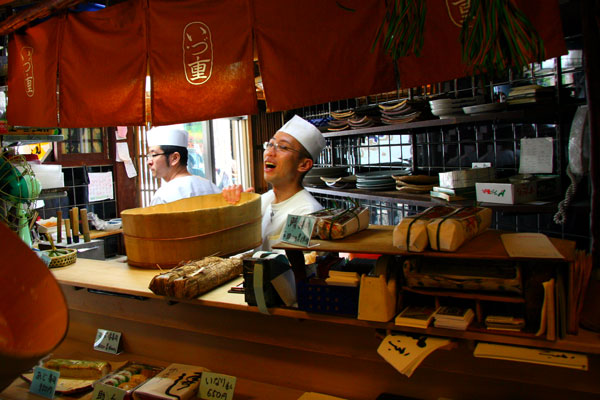
Overall it was the most traditional experience for Kansai-style Sushi, and if we were to go back to our townhouse right away I would have bought a pack of Inari Sushi (650 yen) for take-out. And largely due to the absolutely incredible Saba Sugata-zushi, it was quite a memorable meal.
Bill for Two Persons
| Saba Sugata-zushi | 1900 yen |
| Deluxe Hako-zushi | 1500 yen |
| Yaki Ayu-zushi | 850 yen |
| TOTAL | 4250 yen (CAD$43) |
Food Review: KATSUKURA (Kyoto Station Branch)
Address: Kyoto-shi Kyoto-Eki-Biru The Cube 11F
Hours: Daily 11:00-22:00
Website/Map: Official Site (in Japanese only)
Directions: You can't miss it -- it's right on top of the Kyoto Station, inside the shopping centre complex on the 11th Floor. Just go to the Isetan Department Store, then take the elevator there up to 11th Floor.

No prestigious historic restaurant this time -- actually it's arguably one of the most popular Tonkatsu chains in Japan. You must be wondering why I'm writing review for a chain outlet, but the reason is, I think this really was an excellent value for my money. Still in doubt? Just look at the huge line-up of Kyoto-ites waiting to get in.
Although Kyoto's cuisine is mostly known for refined traditional fare such as Tofu and local vegetables in elaborate Kaiseki presentation, the ancient capital has also produced this excellent chain for Yoshoku (Japanese-Western fusion). The word "Tonkatsu" itself is an amalgamated term from Ton (pork) and Katsu-retsu (Japanized pronunciation for "Cutlet"), and as the name suggests, it's the popular Japanese version of Schwein-schnitzel.
There are currently five branches of Katsukura in Kyoto alone, even more in Tokyo, and close to 30 nationwide. The flagship branch is located on the bustling Sanjo street, but we decided to visit the Kyoto-Station-Building branch for convenience. As we arrived around 18:45 on a busy Saturday evening, the lineup was already at 20-plus clients -- not bad for a restaurant chain.

It's not difficult to understand its popularity once we were handed the menu while still standing in line outside -- the cheapest 70-gram Tonkatsu Meal started at only 890 yen (CAD$9), while the high-end house special Katsukura Meal would set you back a reasonable 1740 yen (CAD$17). Every set meal included unlimited barley rice, shredded cabbages, pickles and dressing, guaranteeing the most filling meal at even the cheapest price.
But don't let the pricing give you the false impression of a greasy fast-food joint, as you simply can't underestimate the Japanese quality control at even the cheapest of cheap chain restaurants (the excellent MOS Burger comes to mind). Upon sitting down we're given a mortar and pestle to grind our own fresh toasted sesame -- the quality is really in the details.

There's little English on the menu, but it shouldn't matter -- there were enough pictures to point you finger at. We had a really hard time deciding between several really attractive options:
- Tofu Skin Croquette and Pork Fillet - 1440 yen
- Tofu Skin Croquette and Deep Fried Prawn - 1440 yen
- Yonezawa Pork Fillet - 1220 yen
- Zuwai Crab Cream Croquette and Pork Fillet - 1720 yen
- House Special Katsukura Meal - 1740 yen
At the end we settled on two of the more expensive set dinners. We could afford to splurge at a place like this.

My House Special arrived in a wonderfully golden Panko crust, thunderously crunchy and yet light on oil, enclosing a perfectly tender, juicy fillet of pork. And topping with the apple-and-date-infused Tonkatsu sauce and the aromatic smell of freshly-ground sesame, it was simply the best Tonkatsu / pork chop / schnitzel I've ever had in any country. And the 25cm-long gigantic prawn was even better, so succulent and crispy that I even chewed down the tail shell. It's so easy to forget that we're sitting in a family restaurant chain -- I wish my neighborhood Denny's is this good.

You can see the pink, perfectly cooked flesh of the pork cutlet in this picture of my wife's Zuwai Crab Croquette and Pork Fillet Meal -- I just can't imagine how much closer to perfection Tonkatsu can ever get. The cream croquette is another Japanese family favorite, but compared to the amazing pork fillet and prawn it turned out to be somewhat ordinary. I could hardly taste any Zuwai Kani (long-legged crab) in the croquette.

Another one my wife's favorite family dishes -- the Chawan-mushi steamed custard. Huge in size, and pretty decent in taste. Not spectacular compared to the rest of the meal, and I would recommend it only for true Chawan-mushi lovers.
Did I mention the unlimited rice and cabbage salad? Turned out we didn't need the extra portion after all. Given such wonderful taste and generous portions, why should I hesitate to recommend this chain outlet?
Bill for Two Persons
| Zuwai Crab Croquette and Pork Fillet Meal | 1720 yen |
| Katsukura Meal | 1740 yen |
| Large Chawan-mushi | 450 yen |
| TOTAL | 3910 yen (CAD$39) |
Food Review: HISAGO (Higashiyama, Kyoto)
Address: Kyoto-shi Higashiyama-ku Yasaka-Torii-mae-kudaru Shita-Kawaramachi 484
Hours: Daily 11:30-19:30
Website/Map: from Kansai.com (in Japanese only)
Directions: Go to the centre of Yasaka Jinja shrine, and exit the shrine on the South side. The street running North-South in front of you is called Kawaramachi-Dori, and Hisago is about 5 minute's walk straight ahead, on the left side. Use the picture below as a reference since there's no English signage.

This is another inexpensive restaurant serving quality, family favorites at a convenient location at the heart of a tourist district. See our pattern?
At Hisago, the specialty is the ordinary Oyako-Don, served at neighborhood family restaurants at every street corner in Japan. They also serve a Kansai regional favorite of Konoha-Don (using sliced Kamaboko fish cake in place of chicken), but our sole reason for visit was their famous Oyako-Don, the subject of multiple TV and magazine interviews.
Housed inside a renovated Machiya (traditional townhouse) with wooden lattice doors and mullioned windows, Hisago started almost 80 years ago as a Soba noodle house that also served rice dishes. Today their store sign STILL writes their name in archaic Hentaikana script which is no longer in general usage. I wouldn't have even found this place if it wasn't for the little brown plaque on the left that at least presented the Hisago name in Hiragana script. And if you can't read Japanese, I suppose you'll just have to remember the photo above.

In most countries, the success of a restaurant would lead to an expansion of the flooring, followed by opening new branches, and eventually franchising. But Japan is still dotted with many historic, wildly famous restaurants still content to remain small, profitable family businesses passed down from father to son. In the case of Hisago, the seven tables inside hardly gave any hint of its popularity. There was a 45-minute lineup when we originally arrived for lunch, so we came back for an early dinner before the closing time of 19:30.
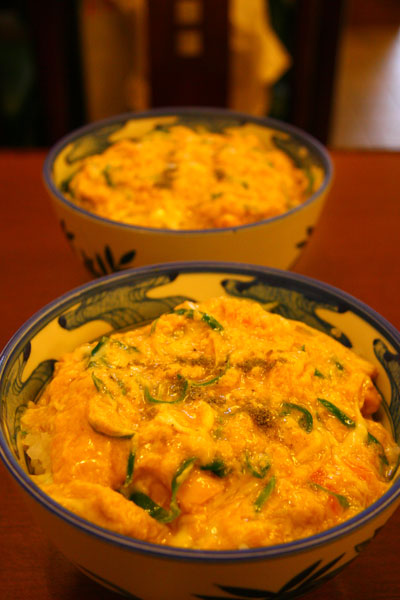
We both ordered the Oyako-Don, which understandably cost a little more than at typical neighborhood restaurants at 980 yen (CAD$10) each. It arrived in a slightly different appearance than the typical Oyako-Don, with a much softer, runnier egg mixture, Kujo green onions instead of Western onions, and a healthy dose of powdered Sansho pepper on top. And the taste was also quite different from the typical Mirin-sweetened family recipes, with the egg mixture taking on the delicately sweet, Umami flavor of Dashi broth, coupled with a slight "kick" from the Sansho pepper. Although not as spectacular as rumoured, it was still the best Oyako-Don I've ever had.
The only possible complaint was that the amount of chicken could have been a little more generous for the given price. Still it was a decent meal for less than 1000 yen in the middle of Kyoto's most popular tourist district -- perhaps it's just the wrong place to be looking for bargains.
Bill for Two Persons
| Oyako Don | 980 yen |
| Oyako Don | 980 yen |
| TOTAL | 1960 yen (CAD$20) |
Food Review: KICCHOMU (Nagakyo-ku, Kyoto)
Address: Kyoto-shi Nagakyo-ku Nishinokyo-Koboricho 1-8
Hours: 17:00-23:30
Website/Map: from Kyotozanmai.jp (in Japanese only)
Directions: Start from the JR Nijo Station and walk north along the Senbon-dori street. It's in the next block, on the left side of the street.
Of the four restaurants reviewed, this was the only non pre-planned visit -- it's an example of the most quintessential Izakaya establishments you'll run into anyday, anywhere in Japan. This one just happened to be several minutes' walk from the townhouse we rented, on an evening when my wife had a huge craving for Izakaya food like Tebasaki chicken wings.
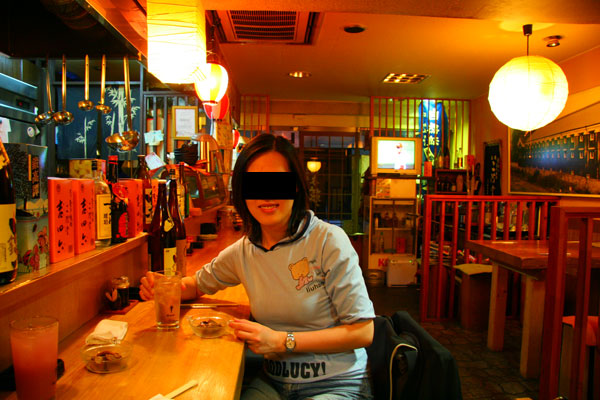
We had been standing the whole day watching the Aoi Matsuri festival, and as we saw the words "Tebasaki - 500 yen" on the menu outside, we immediately walked in without any hesitation.
But after sitting down and ordering a couple glasses of Chu-hai, we found out that Tebasaki was no long served here. Crap ... oh well, time to try something else.
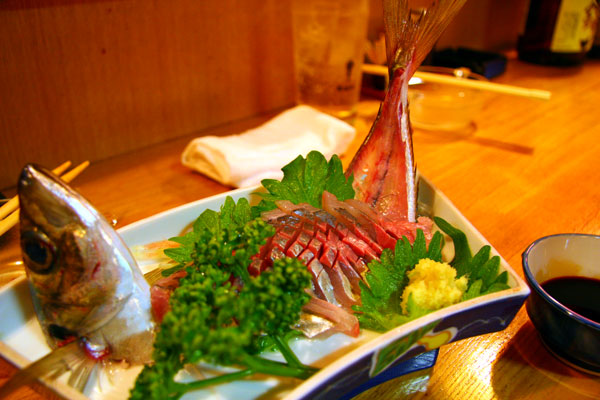
At least one of my favorites was still available -- an excellent Aji-zukuri with the level of freshness I never expected from a little Izakaya in the middle of landlocked Kyoto. Not Tsukiji-Market-fresh, but at least as good as any seafood-focused Izakaya in Tokyo or Osaka.

My wife ordered another one of her favorites in place of the unavailable Tebasaki. The Yaki-Ika was nice and tender, and I was pretty sure it was grilled over real charcoal. I would have preferred spicy mayo as a dipping sauce, but my wife is a purist when it comes to Yaki-Ika and chomped it down straight.
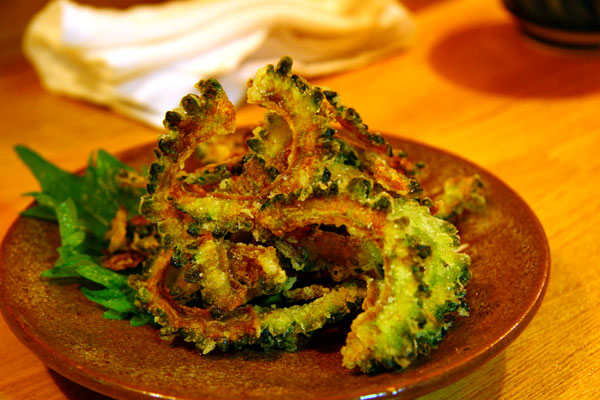
But I think the best dish of the meal was this strange little deep-fried dish that came as part of a 2200 yen (CAD$22) set meal. The thinly-sliced vegetable was crisp, sweet and slightly bitter at the same time, and I had no idea what it was. The Chef called it Goya, and it wasn't until returning to Vancouver that I found out it's the Japanese species of bitter melon.

Eggplant Cheese-yaki ... I think. Again it was quite good. Not spectacular, but more than decent for a little one-man-show Izakaya.

We didn't chat much with the Chef and didn't even know his name, but we did find out that he was originally from Oita Prefecture from faraway Kyushu, as we should have guessed from the collection of sweet-potato-Shochu spirits available behind the counter. The food was surprisingly good overall, but then we were his only client that evening, and so perhaps that allowed him time to perfect our dishes between innings of a live Hanshin Tigers game on TV. Very authentically Kansai.
Bill for Two Persons
| Aji-zukuri | 600 yen |
| Yaki Ika | 700 yen |
| "THE SET" | 2200 yen |
| Lychee Chu-Hai | 500 yen |
| Lemon Chu-Hai | 500 yen |
| TOTAL | 4500 yen (CAD$45) |



No comments:
Post a Comment